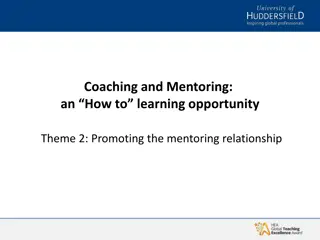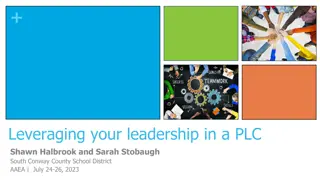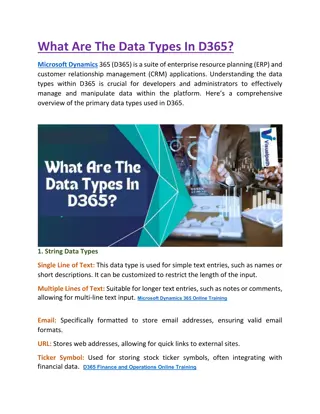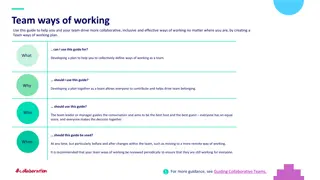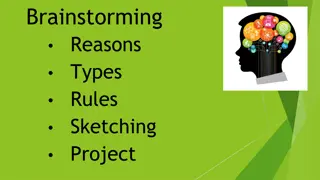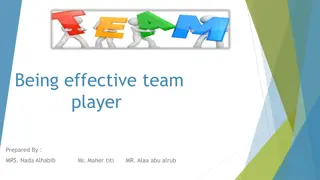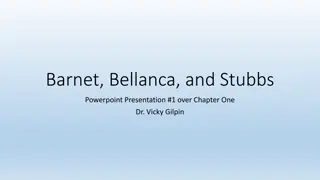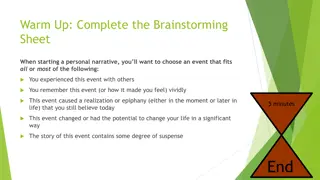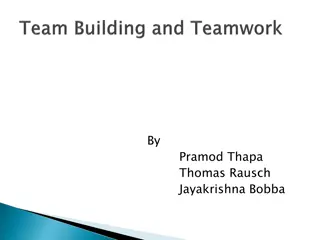Effective Team Brainstorming and Power Dynamics: Strategies for Success
Enhance team brainstorming skills, recognize different types of power dynamics within teams, and learn the differences between delegation and teamwork. Explore the concept of co-powering to elevate team communication and collaborative efforts. Emphasize the importance of structured brainstorming sessions for creative output and team morale.
Download Presentation

Please find below an Image/Link to download the presentation.
The content on the website is provided AS IS for your information and personal use only. It may not be sold, licensed, or shared on other websites without obtaining consent from the author. Download presentation by click this link. If you encounter any issues during the download, it is possible that the publisher has removed the file from their server.
E N D
Presentation Transcript
Effective Brainstorming as a Team Amy Armstrong & Natman Schaye Arizona Capital Representation Project Scottsdale, AZ March 31-April 1, 2016
Imagination is more important than knowledge. Albert Einstein
Brainstorming Goal: increased creative output Secondary gains: elevated morale, good for team building
Not BS Despite the shared initials, brainstorming is not a bull session To be effective, brainstorming follows some rules and is conducted in a structured fashion with an agenda, a note taker, flip charts to capture the flow of ideas, and a To Do list (with individual assignments) at the end
Types of Power PERSONAL: charisma, energy, vision, ability to communicate COLLABORATIVE: ability to join energy/skills POSITIONAL: organizational authority/position EXPERT: knowledge, experience, skills OBSTRUCTIVE: ability to coerce or block CULTURAL: norms, conditioning, privilege re race/class/gender/age CO-POWER: supporting the personal power of others through modeling, validating, feedback
Delegation vs. Teamwork Delegate: entrust (a task or responsibility) to another person, typically one who is less senior. Outcome oriented Hierarchical Emphasizes positional and obstructive power (and maybe others) Teamwork: cooperative or coordinated effort on the part of a group of persons acting together as a team or in the interests of a common cause. Process oriented Non-hierarchical (or at least less) Emphasizes collaborative and co-power
Leading through Co-powering [C]o-powerment is communication that seeks to lift the confidence, energy and agency of another person, self, and the relationship. It is lifting the power of self and others. --Roberto Vargas (activist, cultural psychologist)
Basic Brainstorming Method Identify the specific problem to focus on Select the brainstormers (more about this in a minute) Identify who will facilitate, who will take notes, etc. End with a To Do list with specific assignments for the next team meeting
Basic rules Focus on quantity No criticism: there are no bad ideas Unusual ideas welcome: nothing is too crazy Combine and improve ideas (1 + 1 = 3)
Capital brainstorming Every brainstorming is a team meeting, but not every team meeting is for brainstorming Critical to have full participation of the core team Critical to let everyone have a voice and to value everyone s ideas Optional to expand the core team with others protected by defense privileges
Focus the discussion Brainstorming works when it has a focus The goals is not just to talk about the case but to concentrate on specific problems and come up with new ideas about how to solve them Try to translate big, general topics into better- defined, more specific subjects Give team members advance warning
Capital brainstorming 101: Good facts, bad facts One popular way to get started is simply to ask everyone on the team to shout out the good facts and bad facts Get them all on paper, and keep going until no one can think of another factoid Then see whether any bad facts can be turned into good facts
Some potential topics Jail issues Culture Exhibits Frontloading Getting more money Getting more time Media issues Mental health issues Mitigation Motions Narrative Pleas Race Records Stories and pictures Themes for life Unifying both phases Victim outreach
Jail issues Snitches Conflict with staff Conflict with other prisoners Medical care Mental health care Limitations on visits (time, noncontact, etc.) Nutrition, rest, recreation
Frontloading How do we prove no priors? How do we prove acceptance of responsibility? Remorse? How do we prove emotional state at time of capital offense? How do we prove relative culpability? How might the D.A. open the door to other mitigation in the first phase?
Getting more time What new facts require further investigation? What do we know from past experience about the difficulty of getting specific records? What records requests are outstanding? How many witnesses have we located but not yet interviewed? Where are they? Are they likely to reveal more witnesses? Are more experts needed? When are they available?
See The Checklist Manifesto Surgeon Atul Gawande wrote an interesting book called The Checklist Manifesto (2009) discussing how surgeons, pilots, and the builders of skyscrapers have reduced their risk of bad outcomes by creating checklists David Bruck has distilled this into a checklist for implementing the ABA Guidelines through our team meetings in capital cases
Key concepts Everyone on team accepts the checklist Allocating responsibility for the checklist can enhance the authority of all team members (just as nurses sometimes run through the surgeon s checklist on Dr. Gawande s team) The To Do list must calendar all the tasks Every item on the agenda will generate its own custom-made To Do list



